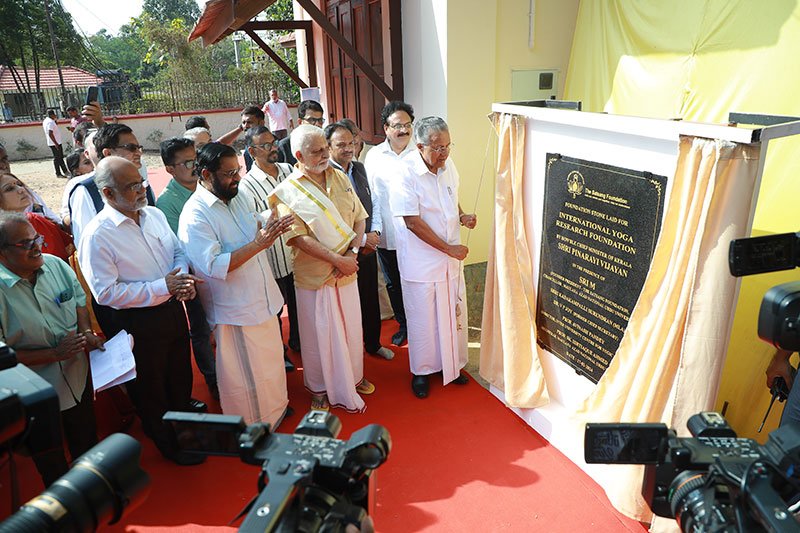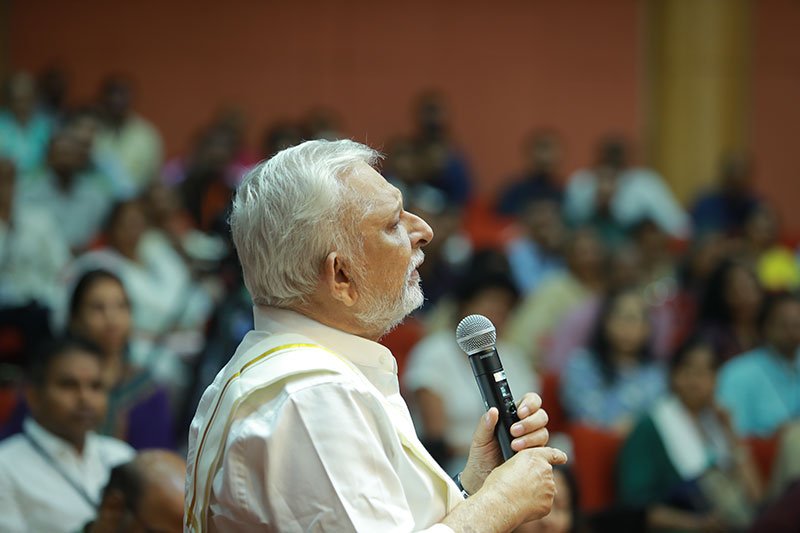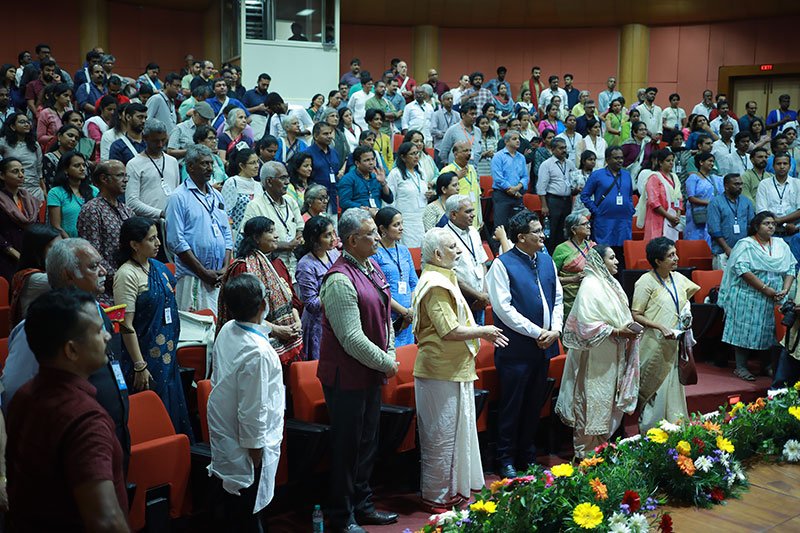In a convergence of spirituality and modern science, the International Yoga Research Foundation (IYRF) recently hosted a landmark event – ‘Colloquium on Yoga and Life Sciences and Beyond (YLSB): Emerging Possibilities for a New World Order’ at Rajiv Gandhi Centre for Biotechnology (RGCB).
Over two enlightening days on February 17th and 18th, 2024, the foundation unveiled a vision that resonated with luminaries and scholars alike.
Day One: Visionary Dialogue on Yoga & Science
Day one started with the foundation stone laying ceremony, a pivotal moment for the International Yoga Research Foundation (IYRF), witnessed the presence of esteemed dignitaries, enhancing its significance. Notable attendees included the Hon’ble Chief Minister of Keralam, Sri Pinarayi Vijayan, Padma Bhushan Sri M (President, Satsang Foundation, and Chancellor of Maulana Azad National Urdu University), Sri Kadakampally Surendran (Hon’ble Member of Legislative Assembly), Dr. V.P. Joy (Former Chief Secretary), Prof. Avinash Pande (Director, Inter University Centre for Yogic Studies), and Prof. SK. Ishtiaque Ahmed (Registrar, Maulana Azad National Urdu University).

“This ceremony marks the start of a journey towards understanding the profound impact of yoga on the human mind and body,” Sri Pinarayi Vijayan remarked as he laid the foundation stone, a tangible step towards realizing the vision of IYRF.
The signing of the Memorandum of Understanding (MOU) between Maulana Azad National Urdu University and IYRF was hailed as a historic collaboration by Dr. V.P. Joy, Former Chief Secretary. “This partnership underscores the importance of blending academic rigor with spiritual insight in our quest for understanding,” he remarked.
The event witnessed the formal alliance of key stakeholders, with IYRF and RGCB leading the charge as prime movers. Supporting institutions included the Ministry of AYUSH, Government of India, and the Inter-University Centre for Yogic Sciences, Bengaluru, among others. Eminent representatives from institutions like SCTIMST, IIT Delhi, and IIT Kharagpur further enriched the dialogue.
Blending Academic Rigor with Spiritual Insights
After the Foundation stone laying ceremony at the IYRF, the focus moved to the 2 day colloquium being hosted at the RGBC Auditorium.
In his inaugural keynote address at the colloquium, Sri M emphasized the need for merging tradition with modern scientific methods. ” IYRF aims to provide a platform from where the best of the Medico-Scientific Research community can combine forces with Yogic practitioners and study the effects of Yogic practice on various health parameters. Yoga is not just a system of exercises but a way of life. Till enough credible, tangible data is not captured and analyzed through the scrutiny of the scientific rigor, Yoga may not get the due it deserves,” he elucidated, setting the tone for the interdisciplinary approach embraced by IYRF.
Drawing inspiration from the Avadhoota Gita, Sri M emphasized the need to study the intricacies of the world to grasp yoga’s essence fully. He expressed optimism about unlocking the human potential through scientific exploration, with the support of key institutions and government backing.
A highlight of the colloquium was the release of ‘Yoga for the Godless’ authored by Sri M, emphasizing the universal applicability of yoga beyond religious affiliations. Throughout the sessions, luminaries from diverse fields shared insights into how yoga could positively impact patient outcomes.
Dr. Manjunath.S, Chair of the Department of Physiology at IIT Kharagpur, presented findings from Electroencephalogram (EEG) studies conducted on Sri M. “Our research aims to unravel the physiological correlates of yogic practices, shedding light on their impact on brain function and cognition,” Dr. Manjunath explained, highlighting the innovative approach adopted by IYRF.
As the first day of the colloquium concluded, the spirit of collaboration and inquiry prevailed, paving the way for future endeavors at the intersection of yoga and science.

Day Two: From Paediatrics to Neurology, Yoga’s Impact Across Specialities
The second day of the Colloquium on Yoga and Life Sciences and Beyond (YLSB) commenced with a series of enlightening sessions led by esteemed medical professionals and researchers, shedding light on the profound impact of yoga across various domains of healthcare.
Dr. Anju Namasivaya, a gynecologist from Bangalore, delved into the role of yoga in obstetrics and gynecology, highlighting its potential to enhance maternal health. She emphasized, “Yoga postures and breathing techniques can significantly benefit pregnant women, improving their overall well-being.”
Following Dr. Namasivaya, Dr. Vinita V. Nair, a paediatrician from Jubilee Memorial Hospital, Thiruvananthapuram, discussed the therapeutic applications of yoga in paediatrics. She shared anecdotes of how integrating yoga into children’s routines improved their energy levels and performance in various activities.
The sessions continued with insights from Dr. Rajesh B. Iyer on yoga’s impact on neurology, Dr. Easwar H. V., a neurosurgeon from SCTIMST, Thiruvananthapuram, on neurological phenomena, and Dr. Jayakumar T.K., HOD of Cardiovascular and Thoracic Surgery at Government Medical College Kottayam, on the link between yoga and heart health.
Dr. Kavita Chandran C., an assistant professor at the Apex Trauma and Emergency Learning Centre, Thiruvananthapuram, shared findings on the metabolic profile among individuals following multilateral healthcare strategies, underscoring the significance of holistic approaches.

A Thought-Provoking Dialogue
The day’s discussions culminated in a thought-provoking dialogue between Sri M and Dr. Jayakumar T.K., wherein they explored the expansive nature of yoga beyond its conventional perception. Sri M urged for a broader understanding of yoga, stating, “Yoga is the clearing of the mind of all its disturbances, and scientific research can help bridge the gap between its traditional wisdom and modern understanding.”
Professor Chandrahas Narayana, lauded IYRF and the conference’s significance as a pioneering effort in integrating yoga with life sciences. He emphasized the importance of leveraging technological advancements to deepen our understanding of yoga’s ancient wisdom.
The ‘Colloquium on Yoga and Life Sciences and Beyond’ concluded on a harmonious note, symbolized by the collective chanting of ‘Om,’ signifying unity among all participants. As the colloquium drew to a close, it left a resounding message of hope and collaboration in harnessing yoga’s potential for holistic well-being.
